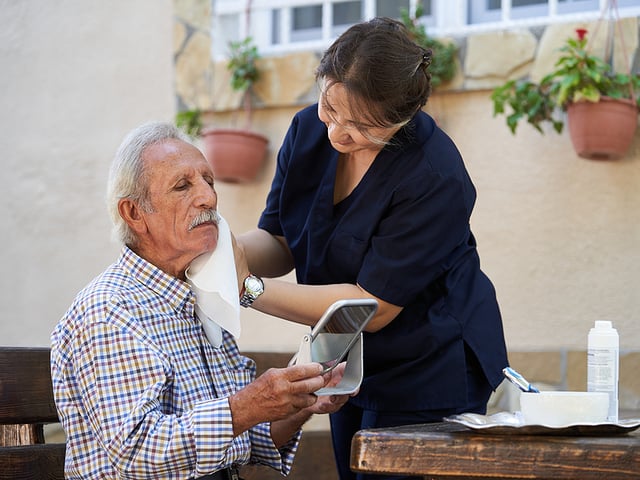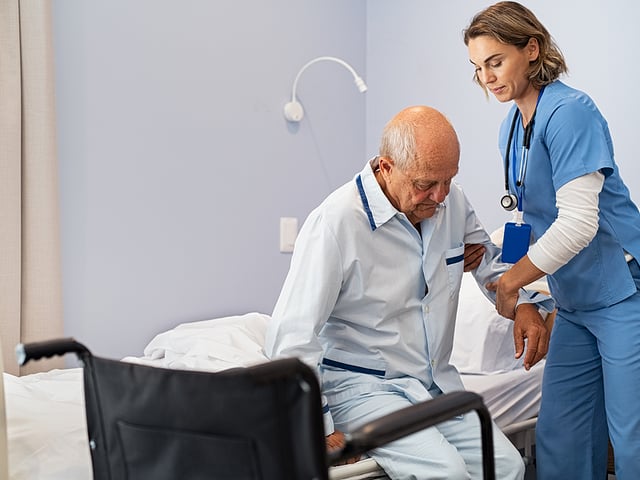
CNA Skills: Assisting with Personal Care Part 2
Welcome to Part 2 of our series, “CNA Skills: Assisting with Personal Care.” In the first part of this series, we discussed five fundamental personal care assistance skills that you, as a Certified Nursing Assistant (CNA), will need to master for your exam. Now, we delve deeper into the subject matter and review the remaining six crucial skills.
Keep in mind that while the number of skills tested in the CNA exam can vary based on your state’s regulations, it is almost certain that personal care skills will be part of the assessment. So, let’s move forward and expand your knowledge on these essential competencies.
The Final Six Personal Care Skills
Be sure to follow Opening Procedure before starting each task and end with Closing Procedure.
Female Perineal Care
Female Perineal Care is a fundamental task for CNAs, particularly when caring for female patients. Regular perineal care is essential for the prevention of urinary tract infections (UTIs) and maintaining overall hygiene. This task may appear daunting at first, but by following each step with precision and care, you can perform it with ease and ensure the patient’s comfort and safety.
The process begins with the Opening Procedure. This involves properly introducing yourself to the patient, confirming the patient’s identity, explaining the procedure, and ensuring the patient’s comfort before you begin. After washing your hands thoroughly, put on gloves to ensure hygiene is maintained throughout the procedure.
Next, assist the patient into the frog-leg position if necessary, ensuring that you respect their privacy throughout. A waterproof barrier pad should be placed underneath the patient, not only to protect the bed linens but also to promote a sanitary environment.
Now, prepare a basin of warm water and washcloths. Warm water is used for comfort and to avoid causing any shock to the patient with colder temperatures. Additionally, you should have enough washcloths available to use a fresh portion for each stroke when cleaning the perineal area.
The cleaning process should always be conducted from front to back. This directional cleaning is important as it prevents the spread of bacteria from the anal area to the urinary tract, thus reducing the risk of UTIs.
Once the perineal area has been thoroughly cleaned, gently rinse it, ensuring all soap has been removed as any residue can lead to irritation. Following this, the area should be patted dry, using a soft towel to prevent causing any discomfort to the patient.
After completing the cleaning and drying process, remove the waterproof barrier. It’s important to remember to dispose of dirty linens in a proper linen bag or designated area, to prevent cross-contamination. After this, change your gloves.
Once the procedure is done, help the patient back into a comfortable position. Ensure they are comfortable and have everything they need close to hand. Lastly, the Closing Procedure involves reassuring the patient, letting them know what they should expect next (i.e., when you’ll be back to check on them), and then washing your hands once you’ve left the room.
Performing Female Perineal Care properly and regularly is essential for the wellbeing of your patients. It is not only a testable skill in your CNA exam, but it is also a daily part of working as a CNA, highlighting the importance of mastering this task.
Shaving
Shaving is an essential personal care skill, especially for male patients who are unconscious or disabled and are unable to carry out this task themselves. Maintaining regular grooming standards can have a significant impact on the patient’s self-esteem and overall well-being, making this a vital part of their care.
To begin the procedure, follow the Opening Procedure as you would with any other care task. This involves introducing yourself to the patient, ensuring their comfort and explaining what you’re about to do. For patients who are conscious, it’s crucial to gain their consent before proceeding.
Once you have the patient’s consent, gather all the necessary supplies. This includes a shaving cream (if available), a basin of lukewarm water, an electric razor, a towel, a washcloth, and a barrier to keep your workspace clean. A disposable drape or waterproof pad can work effectively to protect the patient’s clothing and bed linens from any water or shaving cream spillages.
To prepare the skin and soften the beard, soak a towel in lukewarm water and apply it to the lower part of the patient’s face. The warm water helps to open up the pores and soften the hair, making the shaving process easier and more comfortable. If available, apply shaving cream to further soften the beard and provide lubrication, reducing the risk of skin irritation.
When it comes to the actual shaving, it’s recommended to use an electric razor. This is a safer option compared to traditional razors as it minimizes the risk of nicks and cuts. Always remember to hold the skin taut and move the razor in the direction of hair growth, not against it. This method reduces the likelihood of razor burn and ingrown hairs.
After shaving, clean the area using a damp washcloth to remove any leftover shaving cream. Pat the skin dry gently to prevent irritation.
Once you’ve finished, dispose of the dirty supplies and linens according to your facility’s guidelines. It’s important to ensure that your work area remains clean to prevent cross-contamination.
Finally, perform the Closing Procedure which includes informing the patient that you have finished the procedure, making sure they’re comfortable and reassuring them about their appearance. As always, ensure to wash your hands thoroughly afterward.
Fingernail Trimming
Fingernail trimming, while a seemingly small task, is an essential aspect of personal care for long-term hospital patients. Unkept nails can become a hazard, potentially causing self-inflicted wounds or unintentionally injuring others due to sharp or ragged edges. Therefore, maintaining proper nail hygiene and length is critical.
After carrying out the Opening Procedure and ensuring the patient is comfortable and has given consent, begin the task by soaking the patient’s fingers in a basin of warm water. This soaking process not only helps to soften the nails, making them easier to trim, but it also loosens any dirt or debris that may be lodged under the nails. Adding a mild soap to the water not only aids in cleaning the nails and fingers but can also be soothing to the patient.
Once the patient’s fingers have been thoroughly soaked and cleaned, gently dry the hands with a soft towel. When it comes to trimming the nails, take extra caution to avoid causing any injuries. The nails should be cut straight across to prevent ingrown nails, which can be painful and potentially lead to infection. Be careful not to cut the nails too short as this can expose the sensitive nail bed and lead to discomfort.
A nail file can then be used to gently smooth out the edges of the nails, removing any sharp corners or rough edges left by the nail clippers. This extra step is important to ensure the safety of both the patient and those around them, as well as contribute to the overall neat appearance of the hands.
If available, applying lotion to the hands after trimming the nails can offer additional comfort and care. This step not only moisturizes the skin, keeping it supple and healthy, but it also provides a relaxing, soothing experience for the patient.
Finally, proceed with the Closing Procedure. This includes cleaning up your work area, ensuring the patient’s comfort, and washing your hands thoroughly.
Assisting Dressing with an Immobile Arm
Having to change clothes with one arm immobilized, due to injury or surgery, can indeed be a challenge. Patients in this situation often struggle with simple tasks that most people take for granted. As a CNA, you play a vital role in aiding these individuals, ensuring that their dignity and comfort are maintained throughout the process. Your assistance can make a significant difference in the daily life of your patients, affirming their dignity and contributing to their overall morale and recovery.
The first step in assisting a patient with an immobile arm is the Opening Procedure. This involves making sure you have all necessary supplies close at hand, including clean clothes or a gown, and ensuring you wash your hands thoroughly. It’s crucial to remember that patient comfort and privacy are paramount. So, during the process, keep the door closed, the curtain pulled, and the patient’s body covered as much as possible.
When it comes to undressing, you’ll find it much easier to start with the patient’s strong, mobile side. By doing this, you can remove the garment smoothly and gently from the immobile arm. The key is to make this process as comfortable and stress-free for the patient as possible. Always remember to move slowly and communicate with your patient throughout, ensuring they are at ease and prepared for each step.
Dressing the patient also requires a specific technique. Start with the weak, immobile arm first. Carefully slide the arm through the sleeve or opening, ensuring you’re moving gently and avoiding any forceful actions. This can be a delicate process, particularly if the patient is experiencing pain or discomfort in the immobile arm, so constant communication and patience are crucial here.
Encourage the patient to participate in the process as much as they are able. This not only gives them a sense of autonomy but also contributes to their physical therapy by encouraging movement in the unaffected areas. If the patient can assist in dressing the strong side of their body, this should be encouraged.
After the dressing task is completed, ensure to dispose of any dirty linens properly. Tidy up the area and make sure the patient is comfortable. Lastly, perform the Closing Procedure which includes washing your hands thoroughly.
Serving and Feeding a Paralyzed Patient
Assisting a paralyzed patient with their meals is a key responsibility for a CNA and is an essential part of maintaining the patient’s nutrition and hydration. As with all care activities, it’s important to begin with the Opening Procedure, which includes hygiene measures such as washing hands thoroughly.
Firstly, always verify the identity of your patient and the meal they have been given. Ensuring that you have the correct patient and their correct meal tray is crucial to avoid potential allergic reactions and dietary violations. This involves not only double-checking the patient’s identification but also checking any dietary instructions or restrictions noted in the patient’s care plan or medical records. Always be vigilant in observing any allergy indicators that may be attached to the patient’s bed or in their room.
Next, take steps to protect the patient and their clothing during the meal. Drape the patient with a towel or a cloth, to prevent food or drink from spilling onto their clothes. This not only helps in keeping the patient clean but also promotes dignity and respect for the patient during feeding.
Before starting to feed the patient, ensure the food is properly prepared. Cut the food into bite-sized pieces, making it easier for the patient to chew and swallow. This can reduce the risk of choking. Also, remember to check the temperature of any warm or hot foods or drinks to prevent burns or discomfort.
Feeding should be done patiently and carefully. Take time to feed the patient slowly, allowing them ample time to chew and swallow. This is not only a safety measure but also allows the patient to enjoy their meal rather than feeling rushed. Offering sips of liquids in between bites can help make swallowing easier and can also provide necessary hydration.
After the meal, ensure the area is clean. Dispose of trash and linens, and clean the over-bed table. Remove the tray and make sure it’s cleaned or returned to the appropriate place.
If required, record the amount of food and drink consumed by the patient. This information can be vital for the care team to track the patient’s nutritional intake and hydration levels.
Finally, complete the task by performing the Closing Procedure, ensuring the patient is comfortable and all necessary hygiene and safety steps have been taken. Providing assistance with eating and drinking is not only a way to care for the patient’s physical needs, but it’s also an opportunity to offer emotional support, companionship, and encouragement, contributing to the overall wellbeing of the patient.
Assisting with Bedpans
If you’re a CNA caring for patients who are bed-bound or have limited mobility, one of your key tasks may involve aiding with bedpans to facilitate the process of voiding. Initiate the process by following the Opening Procedure.
Encourage the patient to move onto their side, offering assistance as necessary, and place a waterproof sheet or pad on the bed to safeguard against spills. The patient should then be carefully guided onto the bedpan, ensuring that the buttocks are correctly positioned over the pan’s opening.
To uphold the patient’s dignity and privacy, drape a sheet or blanket over them. Depending on the patient’s comfort, the head of the bed may be raised. Following this, step aside momentarily, exchange your gloves for a fresh pair, ensuring to wash your hands thoroughly before donning the new pair.
When the patient has finished, lower the bed back to a flat position. Assist the patient to gently roll onto their side while you carefully hold the bedpan steady to avoid spillage. Afterward, remove the bedpan and place it aside on a barrier sheet, ideally on a flat surface like the foot of the bed or a chair.
Next, it is necessary to ensure that the patient’s genital and buttock areas are clean. You may refer to the earlier instructions on perineal care for the appropriate cleaning techniques. Once clean, help the patient back into a position that they find comfortable.
After disposing of the bedpan contents, it’s important to change your gloves once more, and to wash your hands thoroughly for at least one minute to maintain optimal hygiene.
Practice Makes Perfect
In conclusion, these six skills are paramount for any Certified Nursing Assistant (CNA) to master. From female perineal care to assisting with dressing an immobile arm, each of these skills carries its unique importance and application. They all contribute to the holistic care of the patient, not just physically, but also emotionally and psychologically, reaffirming their dignity and boosting their morale.
However, understanding these skills is only the first step. Mastery comes with practice and hands-on experience. As a prospective CNA, it’s advisable to simulate these scenarios with a study partner in a lab setting, and to take practice tests to fully grasp the techniques and processes involved.
This marks the end of our series on “CNA Skills: Assisting with Personal Care.” Our hope is that you will not only pass your CNA exam with flying colors but also become a skilled, empathetic, and effective caregiver who can make a significant difference in the lives of your patients. So, keep studying, keep practicing, and all the best for your upcoming CNA examination!
Keep Reading

Certified Nursing Assistant Exam Blog
How Long Does it Take to Become a CNA?
As a profession on the frontline of healthcare, Certified Nursing Assis…

Certified Nursing Assistant Exam Blog
How to Do Well on the CNA Skills Test
Over 1.3 million nursing assistants work in our healthcare system today…

Certified Nursing Assistant Exam Blog
What Does a Nursing Assistant (CNA) Do?
Are you interested in exploring medical careers? The healthcare industr…